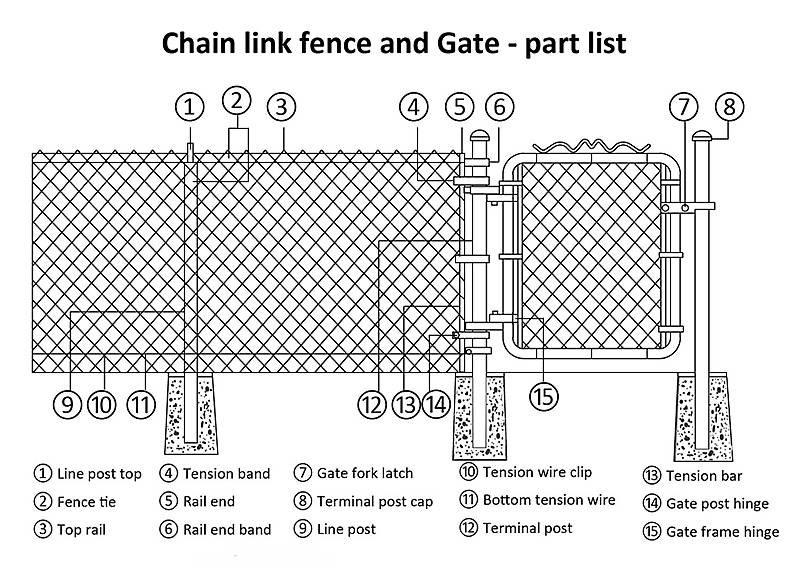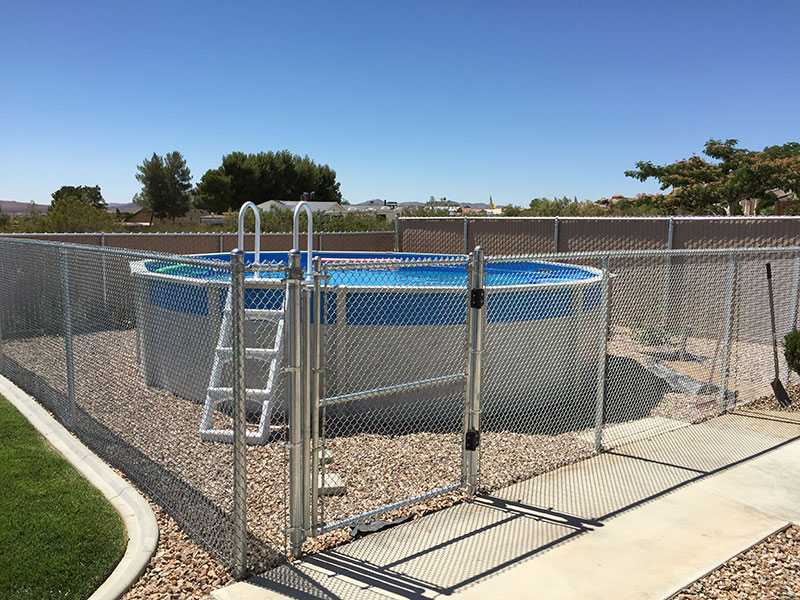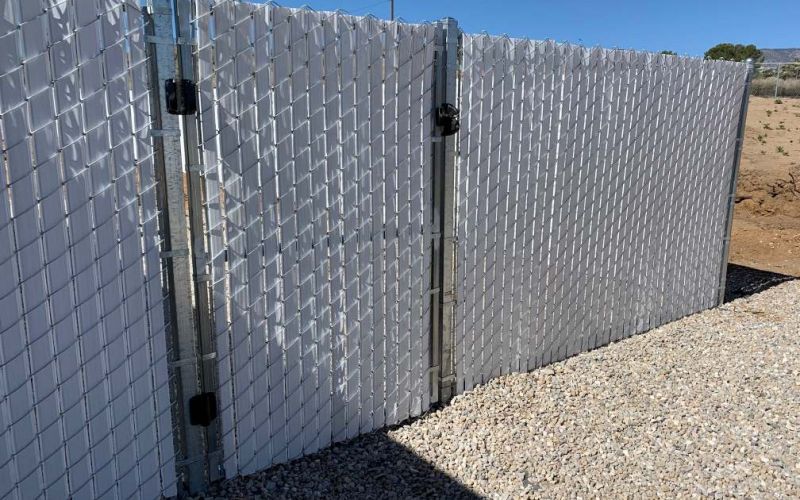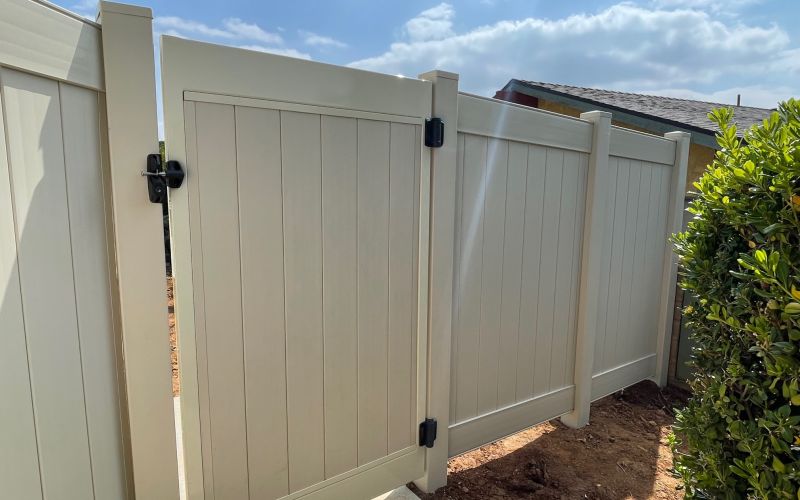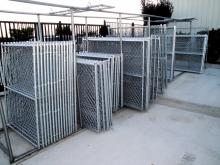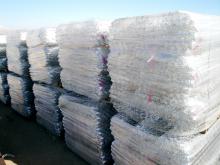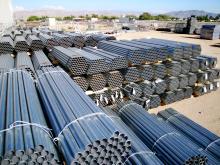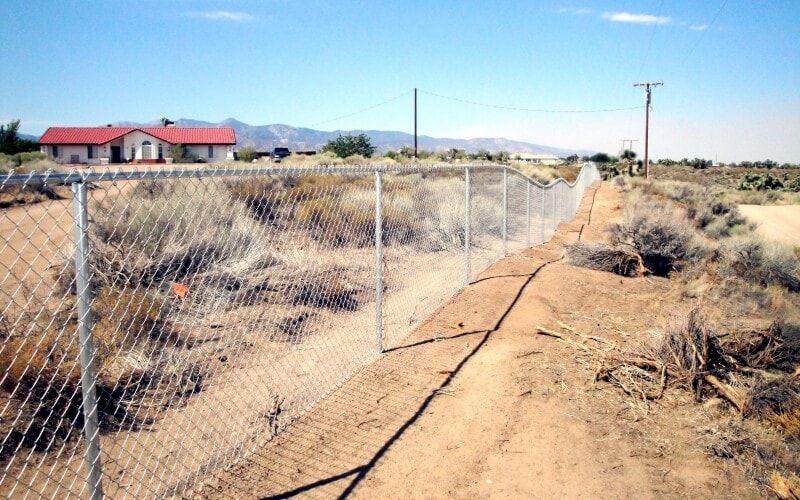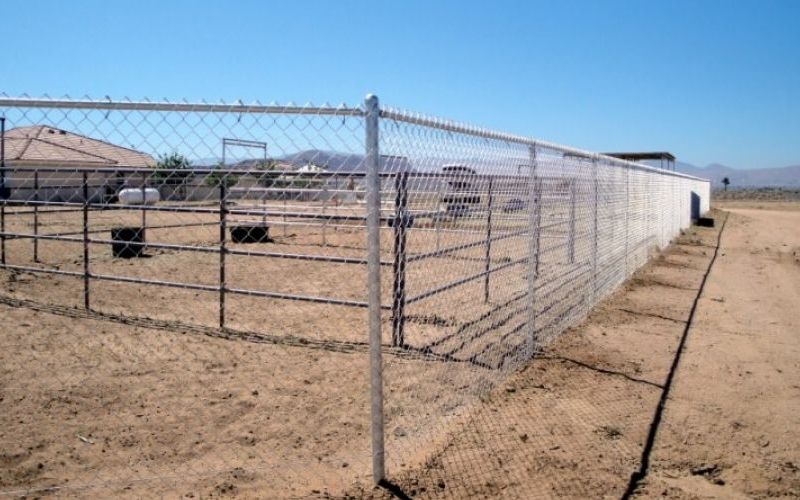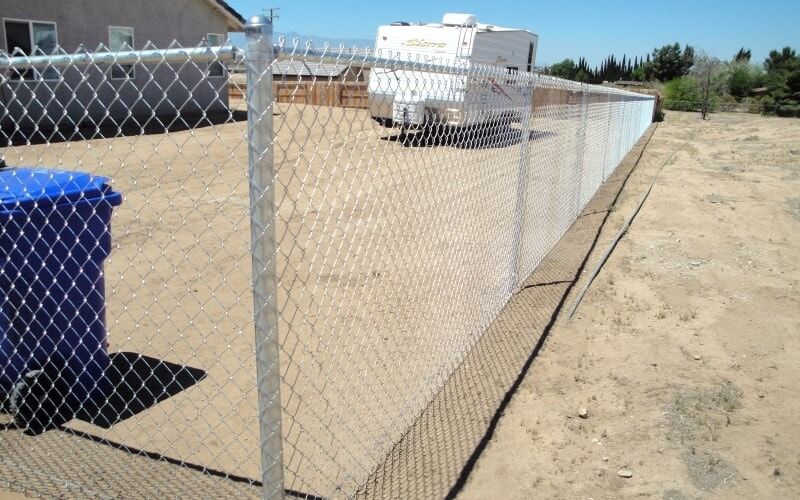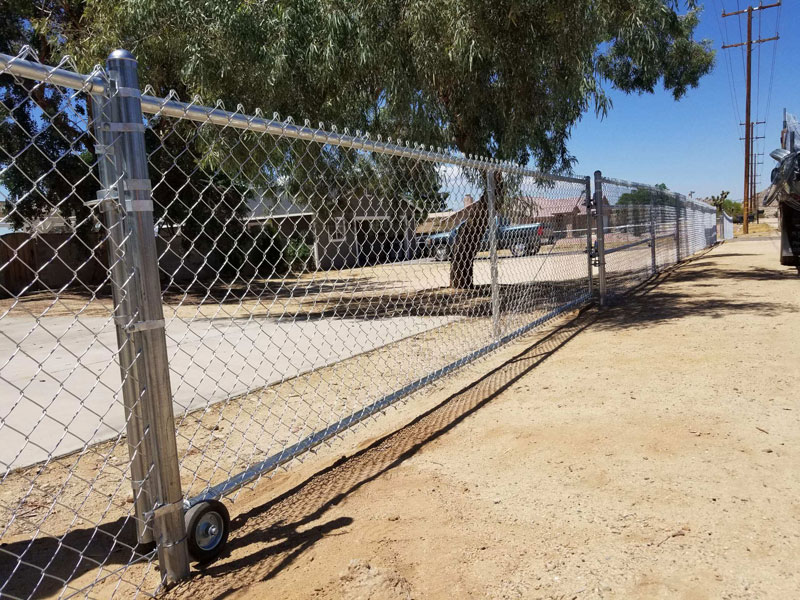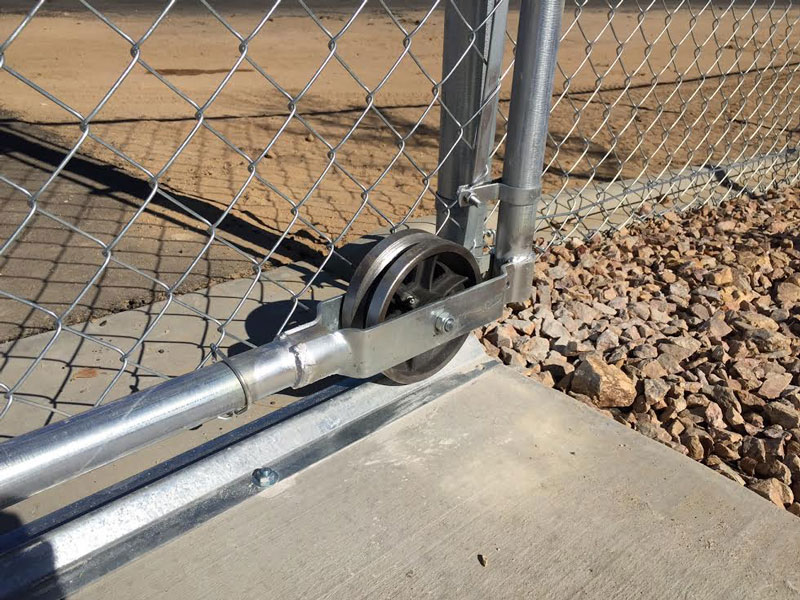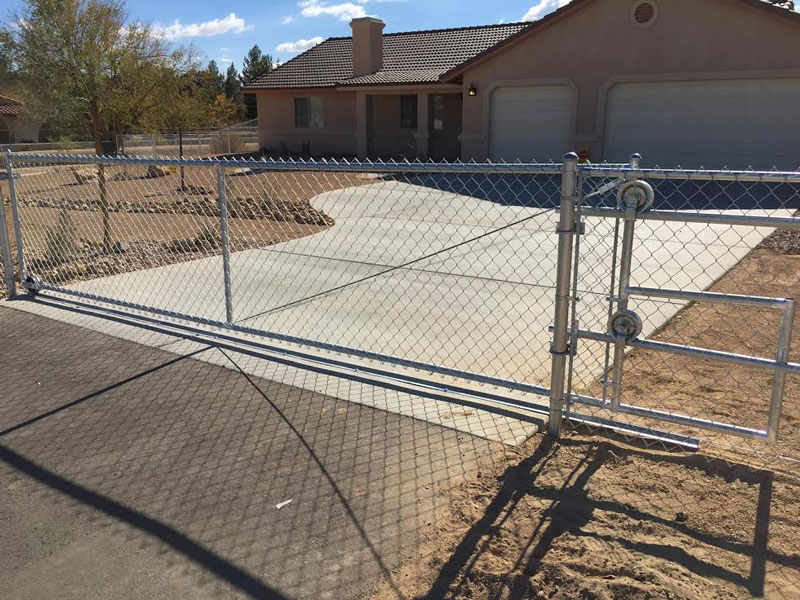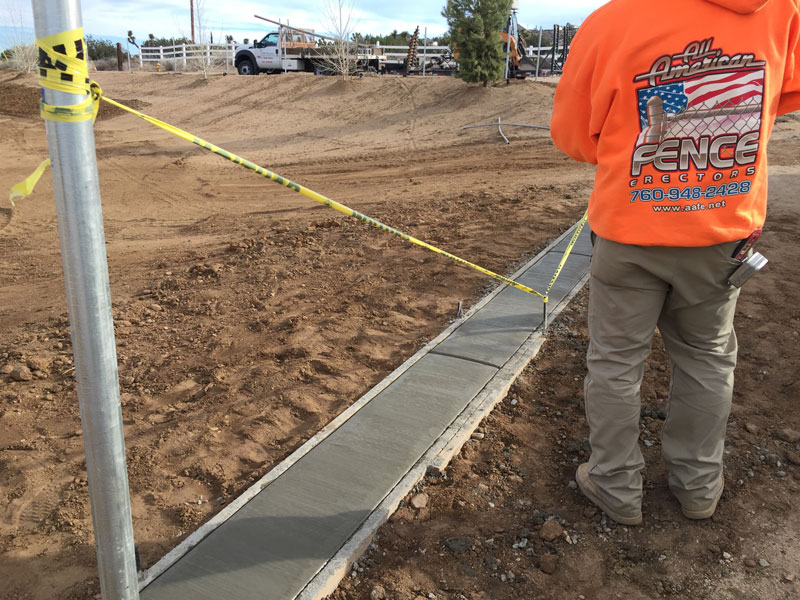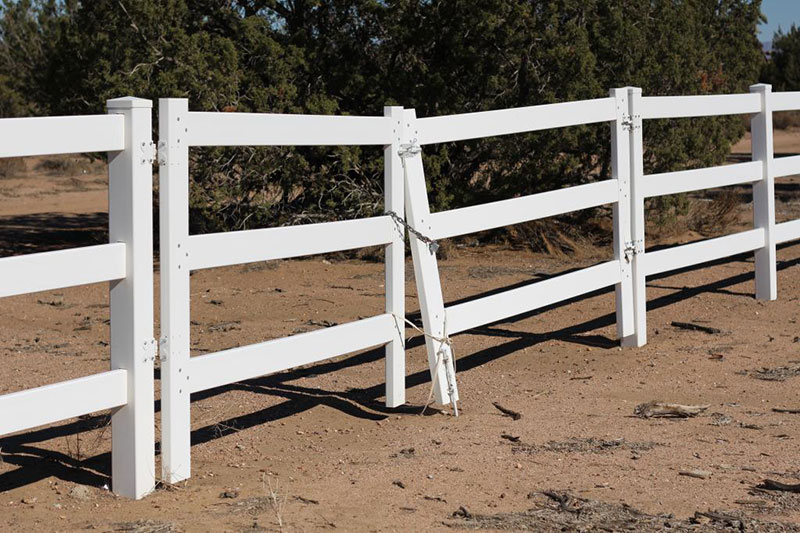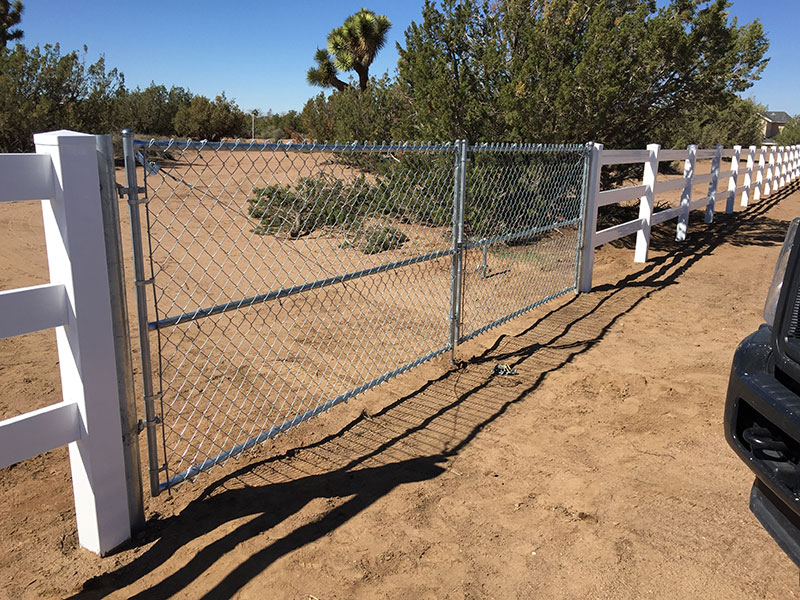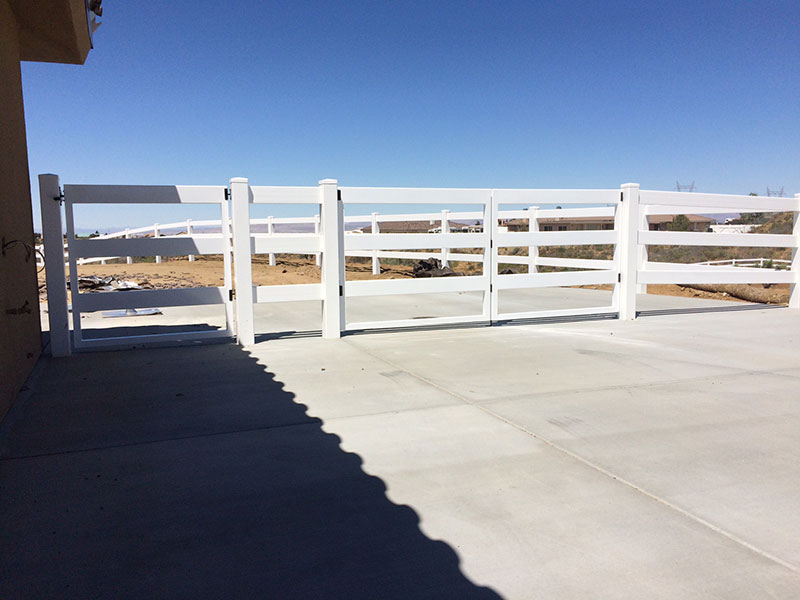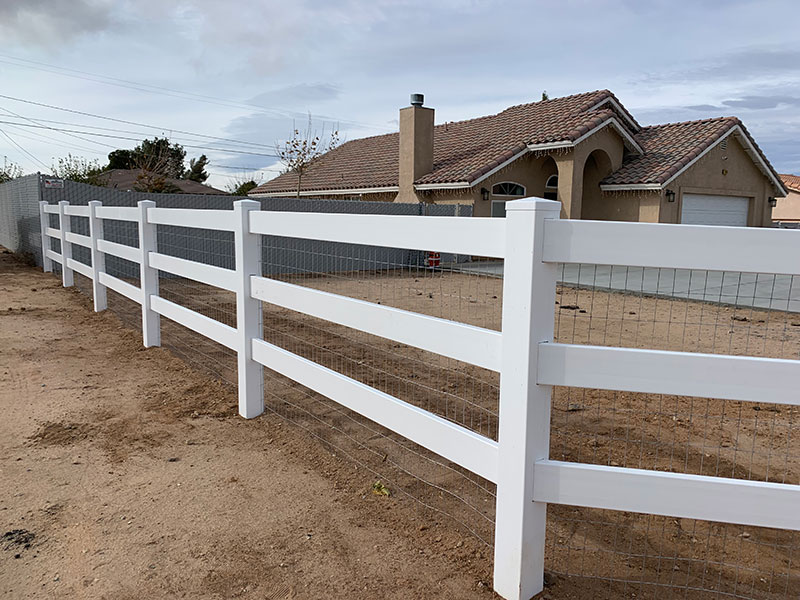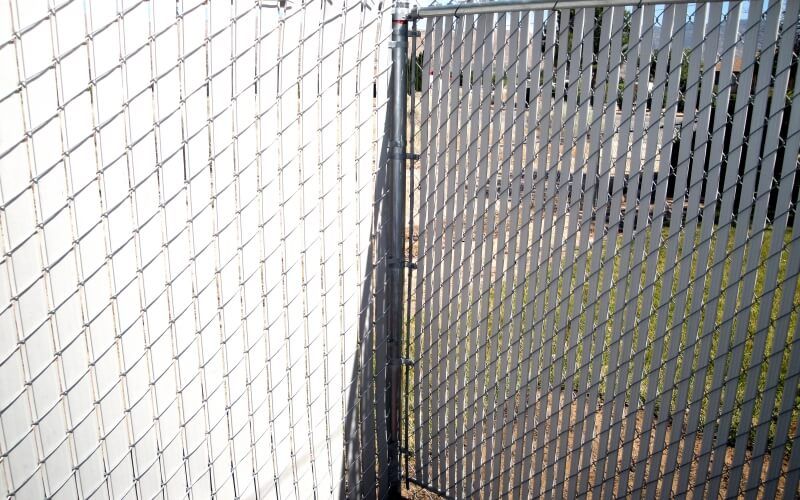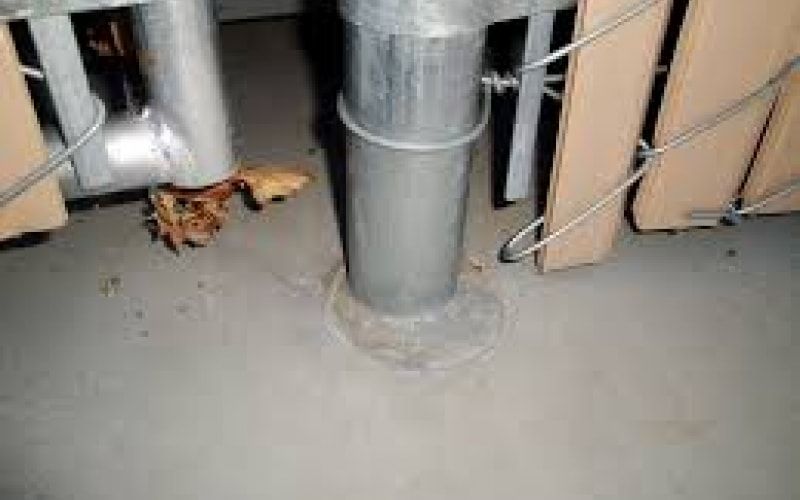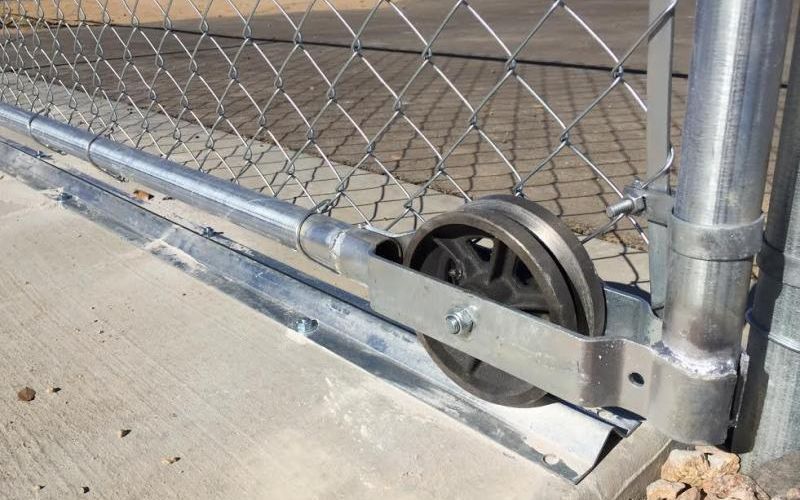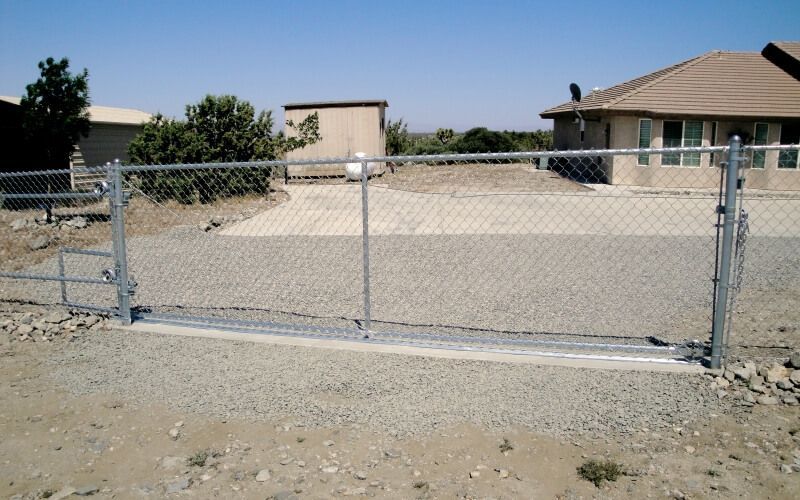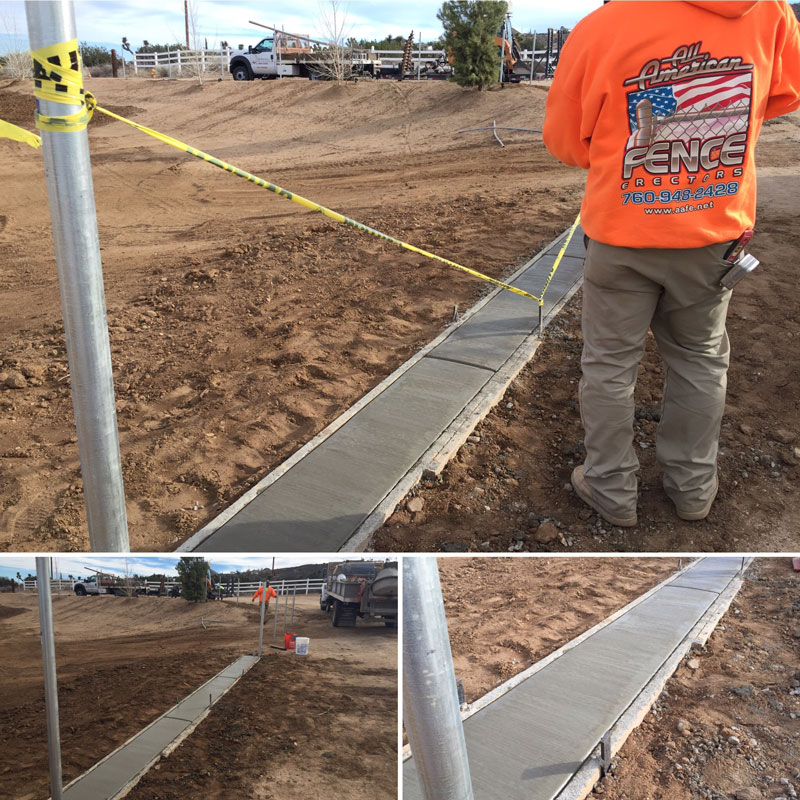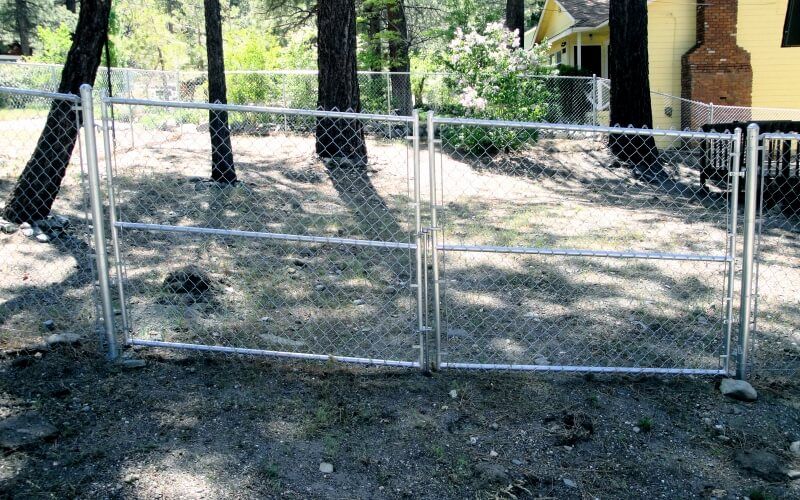Frequently Asked Questions
CHAIN LINK GATES 101
{C}
Walk Thru/Pedestrian Gate:
This is the most affordable and convenient gate to use for simply getting from one side of the fence to the other. Walk-through gates are mostly placed in the fence line where sidewalks are or next to the house for ease of use walking around the house from the front yard to the backyard. Most walk-through or pedestrian gate sizes range from 3’-6’ in width, and our most common size is 4’ wide.
This type of gate is also the easiest to open and close. It is meant for pedestrian traffic only so it can be opened by hand or with a handle that attaches to an electric opener. Just like chain link rolling gates or double swing gates, it's a simple and versatile option for ensuring controlled access to your property.
- This is the most affordable and convenient gate to use for simply getting from one side of the fence to the other.
- Most often walk gates are placed in the fence line where sidewalks are or up next to the house for ease of use walking around the house from the front yard to the backyard.
- Walk gate sizes range from 3’-6’ in width and our most common size is 4’ wide.
Double swing/drive thru gate:
This is the most affordable type of gate to get a car or truck through. Double swing gates range from 10’-20’ in width, and our most common is 12’-16’ wide. Our chain link double swing gates are made with 11 gauge steel, which is thicker than most standard chain link gates. The double swing gate opens up to 180° for ease of use. This allows it to be left open or closed while still providing access at all times.
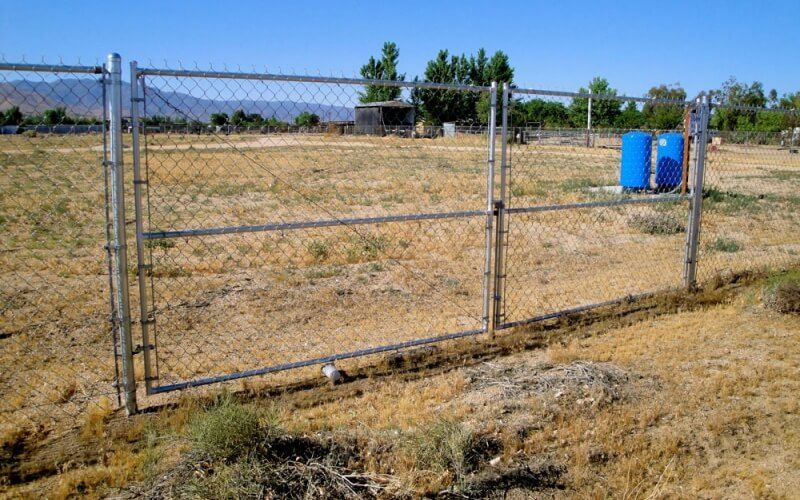
- This is the most affordable type of gate to get a car or truck thru.
- Double swing gates range from 10’-20’ in width, our most common is 12’-16’ wide.
- Most affordable vehicle gate
- Rocky ground or rough asphalt doesn’t affect gate, gate doesn’t touch ground
- Unlike chain link rolling gates, this type of gate doesn’t touch the ground
- Lightweight, swing open and close with little strength/effort
- Grade under the gate should be relatively level for swing clearance
- In windy conditions gates can get blown around when in use, this can be fixed with gate holdbacks.
- If gate gets slammed it is easy for hinges to spin out of adjustment, but usually easy to fix
- Gates are known to sag if heavy abuse is used
- Installing a gate operator is usually not practical on this type of gate
We recommend this gate if infrequent use and/or rough ground is present.
Rolling gate:
A chain link rolling gate is ideal for main driveways where the gate opening is flat, and concrete is underneath the gate opening. This type of rolling gate is for openings from 12'-20' wide. More often than not, rolling gates get a bad rap for wheels hanging up and gates not rolling straight into the gate latch. The good thing is, this can be solved. A rolling gate works best when there's concrete underneath the gate to mount a strip of angle iron for the gate to track/roll-on (2nd photo). Doing this does bring added cost but is well worth it. The wheels will last longer, and much less effort is used when opening and closing the gate. Angle iron provides a consistent, open and close alignment of the gate, similar to a train riding on train tracks, if you will. Chain link rolling gates are the most popular style in today's market. They offer an easy way to secure a property and provide an aesthetically pleasing look.
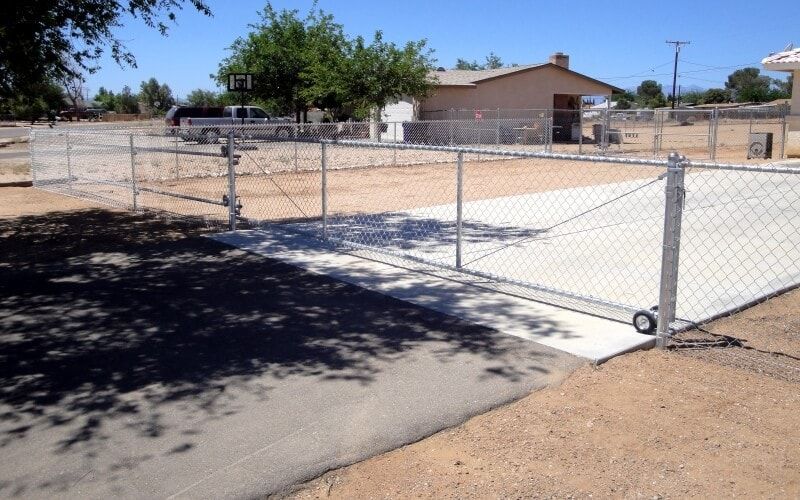
18x4 rolling gate 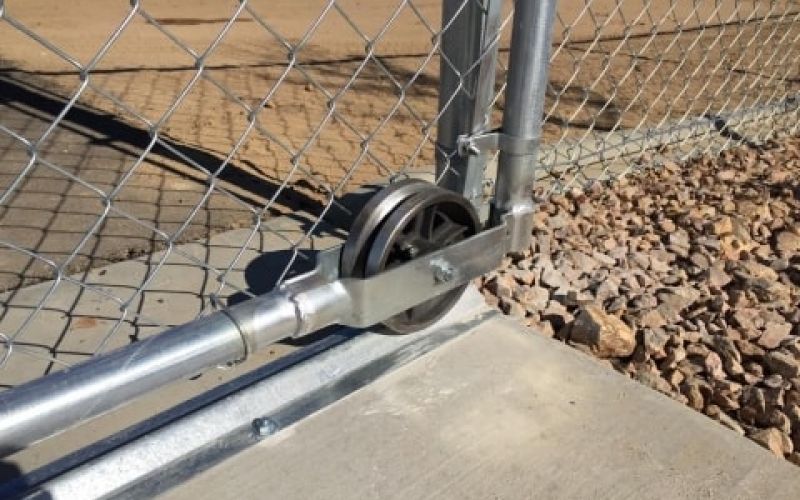
Rolling Gate
This type of gate is ideal for main driveways where the gate opening is flat and concrete is underneath the gate opening. This type of rolling gate is for openings from 12'-20' wide. More often than not rolling gates get a bad rap for wheels hanging up and gates not rolling straight into the gate latch. This can be solved! A rolling gate works hands down the best WHEN there is concrete underneath the gate to mount a strip of angle iron for the gate to track/roll on (2nd photo). Doing this does bring added cost but is well worth it. The wheels will last longer and much less effort is used when opening and closing the gate. Angle iron provides a consistent open and close alignment of the gate, similar to a train riding on train tracks if you will.
- Vehicle can be right in front or behind gate and you can still open/close the gate.
- Gate will never accidentally swing and hit a car, because it rolls parallel to fence.
- Most roll gates are single; opposed to a double swing gate where you have to technically open two gates.
- Potential to add a gate operator with addition of angle iron, v-groove wheel, & tail.
- Gate frame pipe is larger than that of a double swing gate.
- Chain link rolling gates are often more expensive than a double swing gate
- It can be a physical job opening and closing the gate if the ground surface isn't smooth and flat
{C}
We recommend this gate if you have a smooth flat hard surface (ideally concrete) for the gate to roll on and daily use is needed. This gate will always work best if there is concrete under the gate opening, in which case we can mount the angle iron track so the gate alignment is consistent and perfect. Price reflects these options.
For gate openings larger then 20': Click Here
FENCE DIAGRAM
Parts of a chain link fence aren’t mysterious, but if you don’t know what they are called it can be difficult when you talk to builders, contractors, or look for repair parts. If you want to do the work yourself you may spend a lot of time trying to figure out what a single part is called or order the wrong part due to simple confusion.
All of the parts in the fence diagram perform a necessary function and should not be left out of any new construction. They shouldn’t be missing on your fence, even if it’s been in place for 20 years.
Is your fence missing a necessary part? Does it have parts that are not shown in the diagram? If the answer is yes to either of these questions, you may want to contact the professionals at All American Fence Erectors. We can inspect your fence from top to bottom and provide a free written estimate in case you need to take any corrective actions before something breaks! So check today, and make sure your chain link fence has all of the parts in the diagram. A missing part can drastically reduce its dependability when you need it most.
If it’s time for a new fence, choose the pros at All American Fence for top-shelf perimeter protection. Our products can give you peace of mind and enhance and protect your property value. Our agents serve Apple Valley, Hesperia, Oak Hills, Phelan, Victorville, and nearby areas with professional sales and service. We’ll erect an attractive fence on your property with all of the parts on the diagram at a competitive price that is built to last and built to code. Contact us now for a free estimate!
INSTALLATION PROCESS
Every job size differs, but a close rule of thumb on how we run our business is:
- 1 day to set fence posts, all posts are set in concrete (unless stated otherwise)
- Takes 3-4 business days for the concrete to cure and/or make the gates.
- 1 day to stretch the wire and hang the gates
PROPERTY LINES
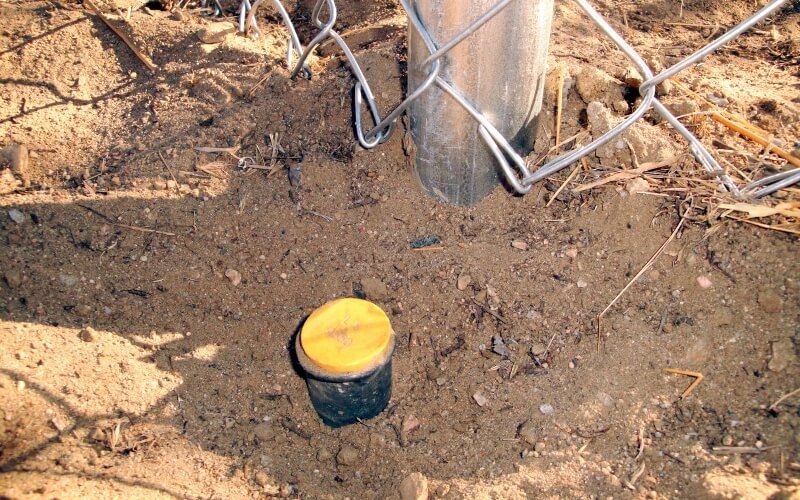
- Property pins/survey stakes are the only way to know 100% where your exact property line is (see photo for what some property pins look like), we can pull a track map with footages to get an idea where they might be and the help of a metal detector often finds them if they are there or buried below.
- In the event we are unable to locate them for you, it would be in your best interest to get the property surveyed so we can ensure the fence is placed in the correct spot. If multiple neighbors have fences that all ‘line up’ then usually you would follow suit and stay inline with them, but again, property pins tell the truth.
- It's always best to pull your fence line in at least a few inches (see photo) for comfort and to avoid the neighbor conversation 'my fence-your fence' debate in the future
- WE THE CONTRACTOR ARE NOT RESPONSIBLE FOR PROPERTY LINE LOCATIONS, EASEMENTS, ROADS OR ANY OTHER BOUNDARY TYPE SETBACKS WITH FENCE INSTALLATIONS.
.
EASEMENTS
There is a possibility there are utility lines running underground or above ground (on power poles) between you and your neighbor’s property. This exact information is often found in your preliminary title report you received when purchasing the home. Sometimes the city can get you this paperwork as well. Do know it isn’t a standard property map; utility easements are only shown on a much more detailed layout like the photo below.
It is always best to place the fence outside of the said easement, leaving free access to the easement at any time. If the total easement is 20’ wide, usually you and your neighbor would split the difference, 10’ each. So if there were property pins in the center of the easement (where the actual property boundary is) your fence should be no closer than 10’ from the property pin. Some easements are obvious, as multiple neighbors have all given in for the easement with their fence and it’s easy to follow suit. Sometimes people do not leave these dedicated easements open for public access and will just allow the utility workers to enter their yard to have access to the utility lines if need be. This, however, can be a headache for all parties involved and should be avoided at all cost, and often illegal if it does in fact show a dedicated easement on your title report. We the contractor shall not be responsible for property line locations, easements, roads or any other boundary type setbacks with fence installations. If it is of any concern contact a licensed surveyor to better assist in the matter.
Fence Height Codes
How Tall Can My Fence Be?
Every city and county has different fencing rules. Before you put up your fence, it is always advisable to check with your local authority for the exact, up-to-date codes. Most cities in the High Desert have set a maximum height of 4’ for front yard fences, and 6’ for backyard fences.
For instance, in San Bernardino County, you can have a four-foot-high chain link fence at the front of your house and a six-foot-high one at the rear of the property. The only EXEMPTION is for properties on "RC" (resource conservation) and "RL" (rural living) land zones, where fences can be as tall as 5' in the front yard.
Even so, many Californian homes still have taller front yard fences than the codes allow. In such cases, the homeowner is always responsible for any problem arising from their extra-tall fence.
So, how high can a fence be in California?
The Town of Apple Valley
The Town of Apple Valley has adopted a new ordinance stating that any home built after June 2007 in zones R-SF and R-EQ CANNOT have chain link fences in the front or front street side yards regardless of what the height is. If this date timeline applies to you, click the "Apple Valley fence height" links below to read more. Also, check the Apple Valley Zoning Map to see which zone you fall in.
Remember, the new ordinance applies only to homes built after June 2007. Although thousands of homes in the area, built before 2007, may have this type of fencing, do not be tempted to go against the code. That may cause you unnecessary trouble.
In addition, you are NOT allowed to fence bare land on residential property in the Town of Apple Valley..
The City of Victorville
The City of Victorville amended its front yard chain link code in February 2015. Lots under 1/2 acre in select areas are NOT allowed to have chain link fences in the front yard regardless of fence height. The zoning that you are allowed to have chain link in the front yard is R-1B 1/2 (1/2 acre or more of land).
In addition, you are NOT allowed to fence bare land on residential property in the City of Victorville. Check the City of Victorville Zoning Map to identify your zone.
City/County Information Links
If you still have questions on how high a fence can go in California, click the links below for more information.
Apple Valley
APPLE VALLEY FENCE HEIGHT 9.28.120
APPLE VALLEY FENCE HEIGHT 9.31.030 / scroll to line "K" walls and fences
APPLE VALLEY FENCE HEIGHT 9.31.050 / scroll to line "M" walls and fences
Adelanto
Hesperia
HESPERIA FENCE HEIGHT Title: 16/ Chapter 16.20/ Article III/16.20.070
San Bernardino
SAN BERNARDINO COUNTY FENCE HEIGHT Page 321 Chapter 83.06
Victorville
Get Swift Professional Assistance
Planning authorities regularly update fencing codes. Keeping up with these changes may be hectic for a regular property owner. Luckily, All American Fence Erectors has a team dedicated to fence building and all the relevant regulations including front, back-, and side yard fence heights and more.. Call us at (760) 948-2428 for any inquiries, and we will be happy to assist.
POOL CODES
TRACTOR WORK
-
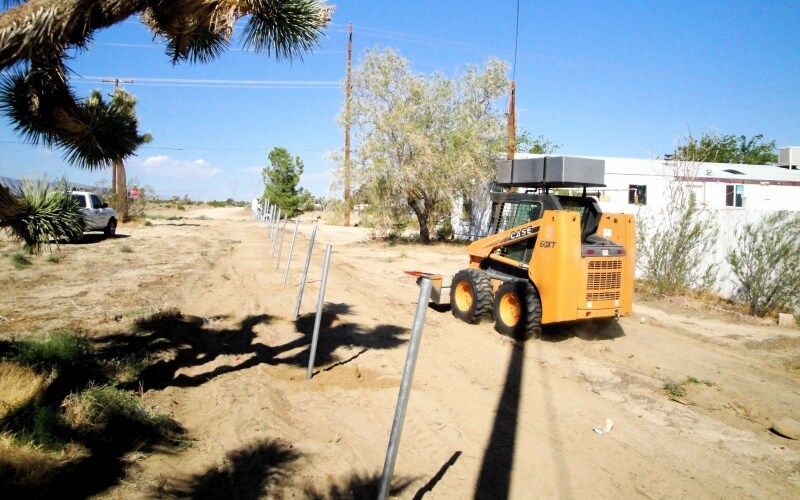
Grade fence lines
-
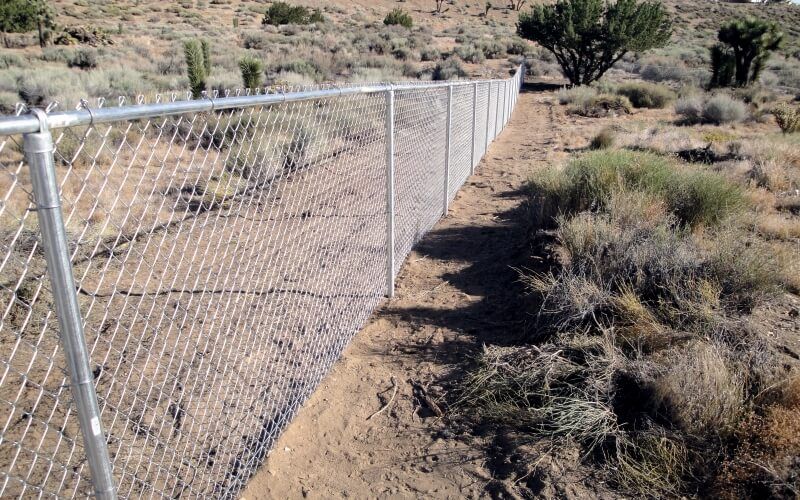
5' chain link
-
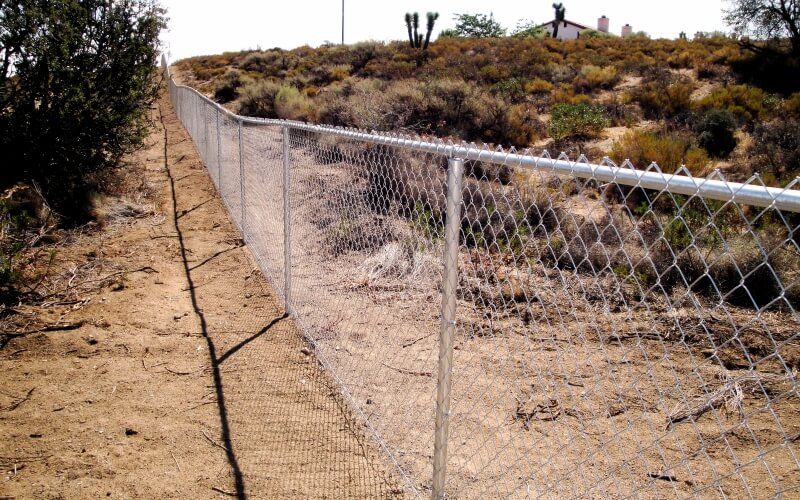
Fence Installation
-
5' chain link, fence line grade
RETAIL SALES
- Your salesman came out and gave me an estimate, but I’d rather save money and do it myself. Can I buy the material from you?
- OF COURSE - We will sell you anything you need. We can often give discounts for purchasing the materials for your entire job (ie: fabric/posts/top rail/fittings).
GATE OPERATORS
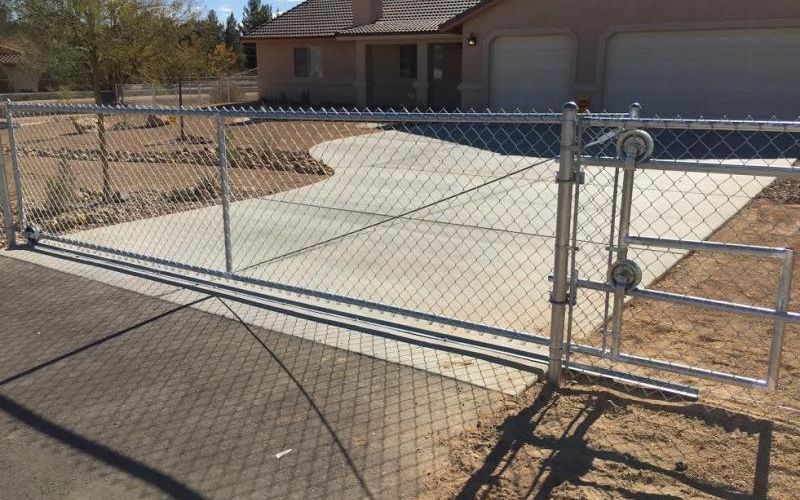
We do not install any gate operators, however, we do work with a few licensed contractors and electrians who can quote and install gate operators for you. We can set up your rolling gate so it is 'ready for an operator' at the time of the fence installation and can then be easily hooked up to an operator at a later date. Things that are a must with a gate operator are; concrete strip under the gate, angle iron bolted to the concrete strip (via concrete anchors), v-groove wheel assembly (welded into the gate), and boxed tail (welded on the end of the gate) that would give added length to surpass the operator when it gets mounted to the ground for chain hookup. The price would increase depending on what the customer already has and how many added upgrades they want on their gate. Give us a call and we would be more than happy to refer you to a few of the companies that handle gate operators specifically.
Why are some fences straight on top and others ‘wavy’?
This all depends on the ground and how much or little gap is acceptable under the fence.
- If the ground is flat or the grade is consistent, then the fence should be flat or straight.
- If the ground has dips or humps the top of the fence must mirror the bottom.
What type of material do you use?
Roll Gate Wheel Options
Roll Gate Wheel Options
Rolling gate wheels are a common gate installation accessory. They can be used with chain link fence gates to provide a rolling gate that is easy to move and open as needed. Whether you own a residential or commercial property, chain link gate wheels can be a great addition to any chain link fencing job, as they provide the flexibility of having an easy way to open and close the gate with no manual lifting or force needed.
We provide two different options for ground wheels on chain link rolling gates: Rubber wheels and V-groove wheels.
Rubber Wheels: Rubber wheels are intended to roll freely over any type of terrain but remember it's only as good as the ground it's rolling on. If you have rocky, sandy, or uneven ground under your rolling gate, it will make opening and closing your gate very difficult. If you have smooth hard-packed level dirt or concrete the rubber wheels work alright, but you often will still need to help guide the gate into the latch which isn't ideal, but if you aren't using the gate too often, it may not be of concern. This rolling gate wheel option is the cheaper of the two and the more common for that reason but it will take two hands and a little muscle to use.
Angle/V-groove Wheel: Angle/v-groove option is the preferred method as the gate guides perfectly in the exact same spot every time you open and close the gate. For this option to work, you must have concrete across the gate opening for the angle/v-track to bolt to. If you do not have a concrete driveway or your concrete driveway doesn't reach the gate opening, we can provide a quote for pouring a small concrete strip that works perfect for the cause (at an additional fee). This option is slightly more expensive but often well worth it and requires very little effort to use. The other plus about this setup is if you ever want to install a gate operator, the only way that will work is to have the angle/v-groove setup. Remember we don't install any of the gate operator/motors, but can refer you to a company that specializes in them for this rolling gate wheel option.
Contact Us Today
Want to enjoy rolling your gate with ease and smoothness? Then we recommend the angle/v-groove option for rolling gate wheels. This will ensure you get the best performance out of your chain link gate wheel options. But if you need a simple and cost-effective way to open and close a chain link gate that you're not using too often, rubber wheels are a great option.
Get your fence installed professionally at All American Fence. Complete the contact form to tell us more about your chain link fence gate wheels project. Get your free estimate now.
Are your prices competitive?
Privacy Vinyl or Privacy Chain Link
- Common question is always; which looks better, or is it worth the extra cost for privacy vinyl over privacy chain link.
- This is mainly subject to opinion of apperance or issue of durabilty (privacy chain link is far more durable then that of privacy vinyl due to it's steel frame work).
- Here is a great photo comparison of the exact same job with both types of fence.
- Typically privacy vinyl costs 35%-45% MORE than privacy chain link.
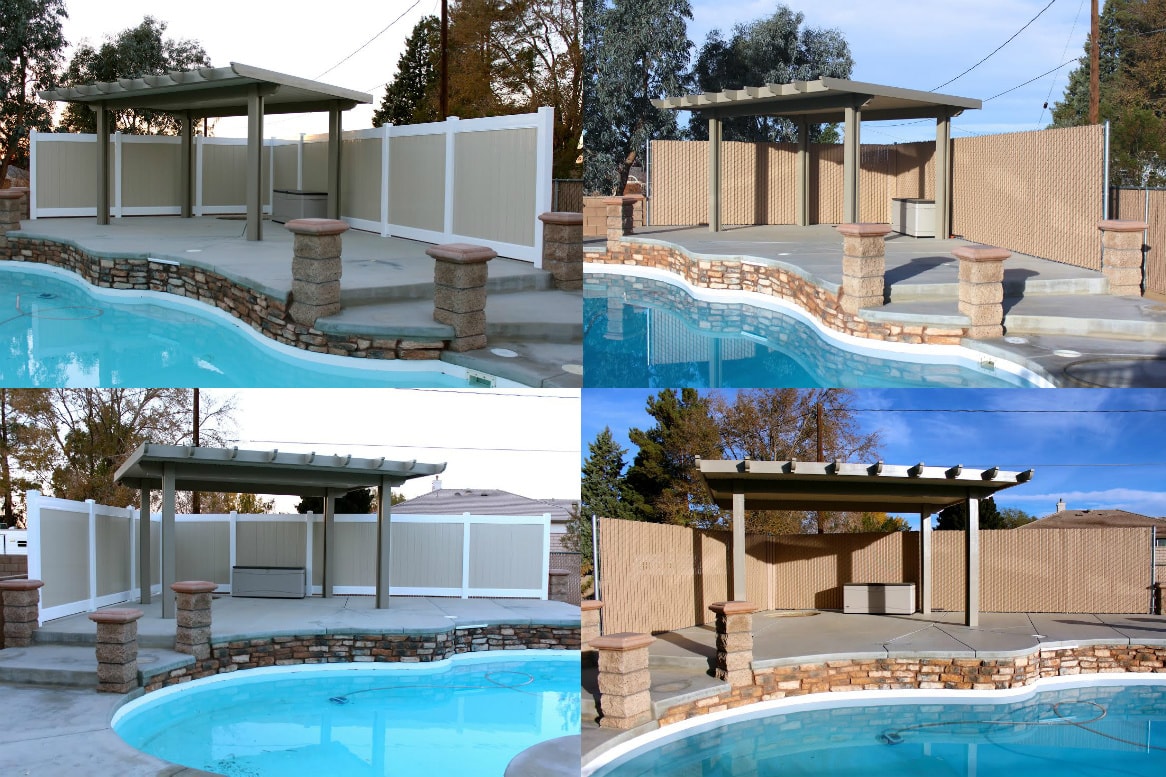
Will my fence rust?
All chain link material and products we sell and install have been galvanized to avoid rust or maintenance.
What’s the warranty on your fences?
- 3 year on material (excludes gate hardware).
- 1 year on our workmanship/installations.
How long will my vinyl fence last?
- Our vinyl fence is made from high quality virgin vinyl raw materials and has UV inhibitors to help prevent fading. It is a very good and durable product but will show wear and marks upon normal wear and tear or certain abuse.
- Like all plastic/vinyl, it will slightly discolor (usually only noticed when compared to brand new side by side) and get brittle over years in the sun.
- Sprinklers spraying water on it can make it dull and blotchy looking.
- Grass trimmings getting thrown at it (weed wacker will make it dull and blotchy with a green tint).
- Any objects hitting or getting thrown at the fence can mark and break/crack the fence.
- If proper care is taken, our vinyl fence will last for years.
-
3 years on material
-
1 year on our workmanship/installations.Exclusions: Vandalism, disaster type weather, wind damage, snow damage, water damage, flash floods (washes), animal or vehicular damage, any vinyl coated or powder coated material, and normal wear and tear.Warranty subject to change without notice:
Do you make vinyl ranch style gates, swing or rolling?
Vinyl gates have always been the missing link to vinyl fences due to lack of durability and appearance (photo 1). We have been developing a structure that we can have confidence in its longevity without compromising the appearance. We have come up with a STEEL design that mimics the design of the ranch style vinyl fence and are powder coated white to match the fence. These have been a customer favorite and it’s easy to see why. They’re made to last and look beautiful (see photos 2-4). We can also incorporate chain link gates within the vinyl fence opening, (last photo), although it doesn't give that superb fit and finish, it is a much cheaper alternative.
Will the Vinyl Ranch Style Fence Keep My Dogs In?
Any pet parent knows the importance of keeping their furry family members safe and secure. A vinyl ranch-style fence provides a classic and stylish security solution for many homes in the High Desert area of California, but is it sufficient to keep dogs contained? The solution lies in having a vinyl dog fence with mesh wire installed on the backside of the fence. The durable vinyl material ensures long-lasting performance and is hassle-free to maintain, making it ideal for environments with pets, while the wire mesh helps keep your dogs and animals out.
How Our Ranch-style Fence With Wire Works
If you already have a vinyl ranch-style fence installed, we can attach mesh wire to the backside of the fence at a cost-effective price. The mesh we use is a 2"x4" galvanized welded wire fence that is attached via self-tapping screws to the fence – usually the backside. If you look closely, the photos show how the mesh is attached so that it disappears in the background and isn't too noticeable. This is what makes our vinyl dog fence a popular option for property owners.
Consider that the mesh is only attached with screws directly into the vinyl/plastic posts, so if you have aggressive animals, they can damage it very easily. It is considered a decorative fence, so keep that in mind when it comes to durability from objects/animals. If you need a more durable fencing solution, you can opt for our chain link fencing and gate installation services.
Get Your Free Estimate
Looking for vinyl dog fencing services? Look no further than All American Fence. With over 30 years of experience in the industry and a 5,000-square-foot warehouse full of parts, not to mention competitive pricing and unbeatable customer service, we're here to help you. Plus, you can start your installation in as little as one to two weeks and enjoy written estimates free of charge. Contact us to discuss your vinyl dog fence installation project today.
Can I slat my existing chain link fence without it blowing down?
- Yes, HOWEVER, additional posts should be set in between existing posts for added strength due to the wind.
- We recommend using 2 3/8" diameter, 16ga thickness for the additional posts.
- Many people make the mistake of slatting a fence that was not intended to withstand wind load.
- NOTE: The slats that fit in standard chain link are NOT the same slats found in Privacy Chain Link, nor do you get the same privacy coverage as 'Privacy Chain Link' (see photo above for comparison). Privacy Chain Link slats come premanufactured with the slats already in the rolls of mesh. These slats wouldn't fit in standard chain link due to their width.
Can I install Privacy Chain Link on my existing chain link posts?
We never recommend this because not only is the Privacy Chain Link thicker gauge wire which is heavier, but the slats are laced so tightly that minimal wind can pass through, which in turn puts a load on the fence. So we highly recommend using materials of greater strength-- not only the posts (min. 2 3/8" line posts set closer together, thickness of the line posts will determine distance between each one) but larger top rail (1 5/8") and steel ties are needed, which usually leaves nothing to be reused.
Do you make rolling gates with the Privacy Chain Link on them?
We do NOT--strictly because the wind load is far too violent with the way roll gates attach to the fence- two steel wheels are the only thing holding a roll gate in place to the fence itself. We don’t want to install something you simply cannot use safely in windy conditions.
Does your company cement the posts in the ground?
- Yes, 99.9% of jobs the posts are cemented in the ground.
- Dirt setting the posts is only for temporary jobs where the customer wants the cost as low as possible.
What if I want the fence over my concrete patio/sidewalk etc.?
- If we need to set a post in your concrete, for whatever reason, we can core drill (see photo above) a hole through the concrete and set our post inside it (via: smooth quick setting cement). OR, we can use a post that has a base plate welded to the bottom of it and use concrete sleeve anchors to bolt it down to your concrete. This method is nice because if in the future you want to remove the post, you’re only left with 4 small bolts that can be hammered down flush.
- Core drilling is usually the best way to go as it leaves the cleanest finished look, as long as you want the post there permanently.
Do I need to call ‘DIG ALERT’ before you put my fence up?
- No. You can if you’d like, however with our insurance, we the contractor, must call in your address for line location. Whether you do or not, we still will.
- There can be ground marking paint, multiple flags and/or whisker tassels placed in the ground to represent the underground utilities. Please don’t pull them out as they are crucial when we dig our post holes.
- There is no way of us knowing what time the utility markings will get done. If you have dogs or locked gates, then they will get in touch with you prior to us starting to set up a time to meet you.
I already have a rolling gate; can I hook up a gate operator to it?
An operator can be installed to your rolling gate if your gate is equipped with the proper items needed (v-groove wheel assembly & a boxed tail for added gate length, as well as a concrete strip for the gate to roll on for angle iron to attach to). Most of the time gates aren’t set up for an operator, in which case we would have to modify your gate and depending on the condition your gate is in, possibly make you a completely new roll gate.
The opening for my gate is far from level, how does this work?
Ideally you want your gate openings as level as possible for ease of use, however, we can build a gate with the correct amount of ‘hill side’ in it to match the slope of the ground. This would make the gate shape a ‘parallelogram’.



